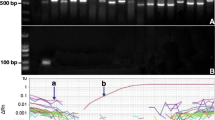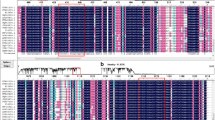Abstract
The toluene dioxygenase (todC1) gene and its mRNA transcripts were amplified by in situ PCR and in situ RT-PCR, respectively, in intact cells of the bacterium Pseudomonas putida F1. In situ amplicons of DNA and mRNA were then detected by hybridizing to a fluorescently labeled oligonucleotide. In situ PCR protocols were developed to distinguish between cells of P. putida F1 (possessing the todC1 gene) and P. putida AC10R (lacking the todC1 gene); the method was sensitive enough to detect amplified products from a single copy of the todC1 gene. P. putida F1 cells were also introduced into seawater with toluene addition. Cells expressing todC1 and total cells were detectable by in situ RT-PCR and Yo-Pro 1 counterstaining, respectively. Nearly 90% of cells expressing the todC1 gene were detected in seawater amended with toluene at day 3, but no cells expressing todC1 were detected in seawater not exposed to toluene. Our results suggest that in situ PCR amplification can be a useful technique for studying presence or absence of a specific gene and gene expression of bioremediative bacteria at the individual cell level following release into natural environments.
Similar content being viewed by others
References
Alfreider, A., J. Pernthaler, R. Amann, B. Sattler, F-O. Glockner, A. Wille & R. Psenner, 1996. Community analysis of the bacterial assemblages in the winter cover and pelagic layers of a high mountain lake by in situ hybridization. Appl. envir. Microbiol. 62: 2138–2144.
Amann, R. I., B. J. Binder, R. J. Olson, S.W. C hisolm, R. Devereux & D. A. Stahl, 1990. Combination of 16S rRNA-targeted oligonucleotide probes with flow cytometry for analyzing mixed microbial population. Appl. envir. Microbiol. 56: 1919–1925.
Amann, R. I., W. Ludwig & K.-H. Schleifer, 1995. Phylogenetic identification and in situ detection of individual microbial cells without cultivation. Microbiol. Rev. 59: 143–169.
Bertani, G., 1951. Studies on lysogenesis. I. The mode of phage liberation by lysogenic Escherichia coli. J. Bact. 62: 293–300.
Chen, F., W. Dustman, M. A. Moran & R. E. Hodson, 1998. In situ PCR methodologies for visualization of microscale genetic and taxonomic diversities of prokaryotic communities. Ch. 3.3.9. In Akkermans A. D. L., J. D. van Elsas & F. J. DeBruijn (eds), Molecular Microbial Ecology Manual, suppl. 3. Kluwer Academic Publishers, The Netherlands: 1–17.
Chen, F., J. M. Gonzalez, W. Dustman, M. A. Moran & R. E. Hodson, 1997. In situ reverse transcription: an approach to characterize genetic diversity and activities of prokaryotes. Appl. envir. Microbiol. 63: 4907–4913.
DeLong, E. F., G. S. Wickham & N. R. Pace, 1989. Phylogenetic stains: ribosomal RNA-based probes for the identification of single cells. Science 243: 1360–1362.
Foght, J.M. & D.W. S. Westlake, 1991. Cross hybridization of plasmid and genomic DNA from aromatic and polycyclic aromatic hydrocarbon degrading bacteria. Can. J.Microbiol. 37: 924–932.
Gibson, D. T., M. Hensley, H. Yoshioka & T. J. Mabry, 1970. Formation of (+)-cis-2,3,-dihydroxy-1-methylcyclohexa-4,6-diene from toluene by Pseudomonas putida. Biochem. 9: 1626–1630.
Gibson, D. T., J. R. Koch & R. E. Kallio, 1968. Oxidative degradation of aromatic hydrocarbons by microorganisms. I. Enzymatic formation of catechol from benzene. Biochem. 7: 2653–2662.
Giovannoni, S. J., E. F. D eLong, G. J. Olsen & N. R. Pace, 1988. Phylogenetic group specific oligonucleotide probes for identification of single microbial cells. J. Bact. 170: 720–726.
Hirons, G. T., J. J. Fawcett & H. A. Crissman, 1994. TOTO and YOYO: New very bright fluorochromes for DNA content analyses by flow cytometry. Cytometry 15: 129–140.
Hodson R. E., W. A. Dustman, R. P. Garg & M. A. Moran, 1995. In situ PCR for visualization of microscale distribution of specific genes and gene products in prokaryotic communities. Appl. envir. Microbiol. 61: 4074–4082.
Jin, L., X. Qian & R. V. Lloyd, 1995. Comparison of mRNA expression detected by in situ PCR and in situ hybridization in Endorcrine cells. Cell Vision 4: 314–321.
Lee, S. & P. F. Kemp, 1994. Single-cell RNA content of natural marine planktonic bacteria measured by hybridization with multiple 16S rRNA-targeted fluorescent probes. Limnol. Oceanogr. 39: 869–879.
Long, A. A. & P. Komminoth, 1995. In situ PCR: General methodology and recent advances. In Gu J. (ed.), In situ Polymerase Chain Reaction and Related Technology. Eaton Publishing Co., Natick, Massachusetts: 23–34.
Pemberton, J. M., 1983. Degradative plasmids. Internatl. Rev. Cytol. 84: 155–183.
Porter, J., R. Pickup & C. Edwards, 1995. Flow cytometric detection of specific genes in genetically modified bacteria using in situ polymerase chain reaction. FEM Microbiology 134: 51–56.
Porter, K. & Y. S. Feig, 1980. The use of DAPI for identifying and counting aquatic microflora. Limnol. Oceanogr. 25: 943–948.
Sayler, G. S., M. S. Shields, E. T. Tedford, A. Breen, S. W. Hooper, K. M. Sirotkin & J. W. Davis, 1985. Application of DNA-DNA colony hybridization to the detection of catabolic genotypes in environmental samples. Appl. envir. Microbiol. 49: 1295–1303.
Schell, M. A., 1985. Transcriptional control of the nah and sal hydrocarbon degradation operons by the nahR product. Gene 36: 301–309.
Sobecky, P. A., M. A. Schell, M. A. Moran & R. E. Hodson, 1992. Adaptation of model genetically engineered microorganisms to lake water: growth rate enhancements and plasmid loss. Appl. envir. Microbiol. 58: 3630–3637.
Tolker-Nielson, T., K. Holmstrøm & S. Molin, 1997. Visualization of specific gene expression in individual Salmonella typhimurium Cells by in situ PCR. Appl. envir. Microbiol. 63: 4196–4203.
Trebesius, K., R. Amann, W. Lugwig, K. Mühlegger & K-H. Schleifer, 1994. Identification of whole fixed bacterial cells with nonradioactive 23S rRNA-targeted polynucleotide probes. Appl. envir. Microbiol. 60: 3228–3235.
Yamaguchi, N., S. Inaoka, K. Tani, T. Kenzaka & M. Nasu, 1996. Detection of specific bacterial cells with 2-hydroxy-3-naphthoic acid-20-phenylanilide phosphate and Fast Red TR in situ hybridization. Appl. envir. Microbiol. 62: 275–278.
Zehbe, I., J. F. Sällström, G. W. Hacker, C. Hauser-Kronberger, E. Rylander & E. Wilander, 1994. Indirect and direct in situ PCR for the detection of human papillomavirus. An evaluation of two methods and a double staining technique. Cell Vision 163: 163–167.
Zylstra, G. J. & D. T. Gibson, 1989. Toluene degradation by Pseudomonas putida F1. J. Biol. Chem. 264: 14940–14946.
Author information
Authors and Affiliations
Rights and permissions
About this article
Cite this article
Chen, F., Dustman, W.A. & Hodson, R.E. Microscopic detection of the toluene dioxygenase gene and its expression inside bacterial cells in seawater using prokaryotic in situ PCR. Hydrobiologia 401, 131–138 (1999). https://doi.org/10.1023/A:1003778108698
Issue Date:
DOI: https://doi.org/10.1023/A:1003778108698




